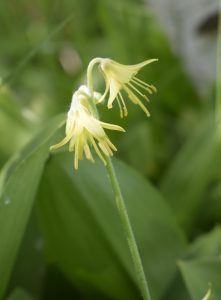Yellow Bluebead Lily

Clintonia borealis, also known as corn lily, is a late May into June wildflower blooming along the lakeshore of Little Bass Lake — and any other shade to part shade, moist habitat of Minnesota’s woods and swamps. The bluebead part of its name refers to the color of the shiny fruit it produces later in the summer, becoming deep blue when ripe. Colonies of this plant can establish themselves, and are appealing both in springtime, with their lily bell-shaped flowers flaring prettily outwards, as well as in fall when they present their decorative berries. The fruit is inedible so be aware; the young leaves, however, can be harvested just before they unfurl when they are the most tender and at their best, traditionally eaten either raw or cooked. Anishinaabe healers traditionally use the leaves medicinally as a poultice for healing open wounds; Anishinaabe children are said to use the leaves for play, biting holes in the leaves to make patterns.
Flowers form in a loose umbel-like terminal cluster of 2 to 8 blooms from a single stem. Flower heads droop, and the tepals (a term for when sepals are not distinguished from petals) are yellow to greenish-yellow with 6 yellow-tipped stamens slightly longer than the tepals, and a long, straight style. Two to 4 leaves grow at the base of the plant, each leaf being up to 8 inches long and 3 inches wide. Leaves are light green, glossy and somewhat stiff with smooth margins (or edges). When biting into the leaves to make patterns, they do make a satisfying crunch. Look for the flowers blooming about the same time as wild geranium, red columbine and starflower. Meanwhile, trillium lingers on, while marsh marigold blooms have faded away.
Formerly in the Lily family, bluebead lily was recently reclassified into the family of Autumn-crocus.
